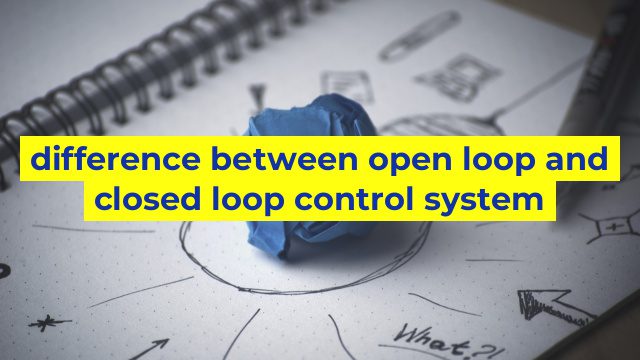Understanding the Differences Between Open Loop and Closed Loop Control System
When it comes to controlling systems, engineers utilize various techniques that allows them to achieve optimal results. Two of the most commonly-used control systems are open loop and closed loop control systems. While both of these systems work towards achieving specific objectives, they function differently and are suitable for different applications. In this article, we’ll be highlighting the differences between open and closed loop control systems.
Open Loop Control System
In an open loop control system, the controller takes an action based on the input signal without considering any feedback from the output signal. It operates on a simple principle of taking corrective action based on the input signal to achieve an outcome. This means that an open loop control system does not incorporate any mechanism to measure or monitor the output of the process it’s controlling.
For instance, consider an irrigation system that uses a timer to distribute water to plants. The timer is programmed to distribute water at specific times, regardless of whether the plants need it or not. In this case, the irrigation system is operating under an open loop control system. While this system is simple and inexpensive, it doesn’t take into account the actual moisture level of the soil, which may lead to over-watering or under-watering the plants.
Closed Loop Control System
Unlike open loop control system, closed loop control system incorporates feedback to monitor the output signal and makes necessary adjustments to achieve a desired outcome. In this system, a sensor measures the output signal and sends the data back to the controller. The controller then assesses the data received and takes corrective action to ensure optimal performance.
For instance, consider a room temperature control system that uses a thermostat to maintain a constant temperature. The thermostat is fitted with a temperature sensor that constantly measures the room temperature and sends the data to the controller. If the temperature deviates from the desired set point, the controller takes corrective action by turning on or off the heating or cooling system until the desired temperature is achieved.
Conclusion
In conclusion, the main difference between open loop and closed loop control system is the inclusion of feedback mechanism. While open loop control systems are simple and inexpensive, they have limited accuracy and reliability. Closed loop control systems, on the other hand, are more complex and relatively expensive, but they offer more accuracy and control over the system being controlled. Engineers must consider various factors such as cost, accuracy, and reliability when choosing between open and closed loop control systems.
Table difference between open loop and closed loop control system
| Control System | Description | Advantages | Disadvantages |
|---|---|---|---|
| Open Loop Control System | A control system in which the controller does not receive feedback from the process or system being controlled | Simple in design, less expensive, stable and reliable, faster response time | Cannot adjust to disturbances, changes in environment or operating conditions, can lead to errors, not suitable for complex systems |
| Closed Loop Control System | A control system in which the controller receives feedback from the process or system being controlled and adjusts the inputs accordingly | Can adjust to disturbances, changes in environment or operating conditions, accurate and precise, suitable for complex systems | More expensive, complex in design, slower response time, possibility of instability or oscillations |

